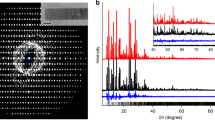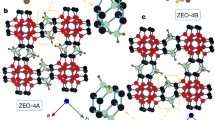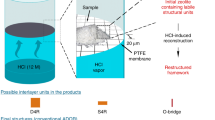Abstract
Synthetic high-silica zeolites (typified by ZSM-5) are powerful catalysts used extensively in the petroleum industry. The channels and cavities of their aluminosilicate framework render their catalytic activity very shape-specific. The varying attributes of individual members of this family depend primarily on subtle changes in framework topology. Unfortunately, these high-silica zeolites are difficult to synthesize as large, that is >100 µm, single crystals, so conventional X-ray structural methods are not appropriate. We have used a combination of techniques to elucidate the framework topology of a new, synthetic high-silica zeolite, Theta-1, which was first prepared as small <2 µm crystals in our laboratories. It exhibits a novel unidimensional 10-T-ring channel system with a medium pore structure, thereby differing from other known structure-types that classify zeolites and suggesting unique shape-selective properties.
This is a preview of subscription content, access via your institution
Access options
Subscribe to this journal
Receive 51 print issues and online access
$199.00 per year
only $3.90 per issue
Buy this article
- Purchase on Springer Link
- Instant access to full article PDF
Prices may be subject to local taxes which are calculated during checkout
Similar content being viewed by others
References
European Patent No. 0057049.
European Patent Application No. 0104800.
Thomas, J. M., Klinowski, J., Ramdas, S., Hunter, B. K. & Tennakoon, D. T. B. Chem. Phys. Lett. 102, 158–162 (1983).
Fyfe, C. A., Thomas, J. M., Klinowski, J. & Gabbi, G. C. Angew. Chem. int Edn Engl. 22, 259–275 (1983).
Barrer, R. M. Hydrothermal Chemistry of Zeolites (Academic, London, 1982).
Breck, D. W. Zeolite Molecular Sieves (Wiley, New York, 1974).
International Tables for Crystallography Vol. A (Reidel, Dordrecht, 1983).
Meier, W. M. Molecular Sieves, 10 (Society for Chemical Industry, London, 1968).
IUPAC Commission, Pure app. Chem. 51, 1093–1100 (1979).
Meier, W. M. & Olson, D. H. Atlas of Zeolite Structure Types (Structure Commission of the International Zeolite Association, Zürich, 1978).
Jacobs, P. A., Beyer, H. K. & Valyon, J. Zeolites 1, 161–168 (1981).
Thomas, J. M. Ultramicroscopy 8, pp 13–25 (1982).
Dwyer, J. Chem. Ind. 258–269 (1984).
Derouane, E. G. in Catalysis by Zeolites (eds Imelik, B. et al.) 5–18 (Elsevier, Amsterdam, 1980).
European Patent Application No. 0065400.
Parker, L. M. & Bibby, D. M. Zeolites 3, 8–11 (1983).
European Patent Application No. 0087017.
European Patent Application No. 0102716.
Author information
Authors and Affiliations
Rights and permissions
About this article
Cite this article
Barri, S., Smith, G., White, D. et al. Structure of Theta-1, the first unidimensional medium-pore high-silica zeolite. Nature 312, 533–534 (1984). https://doi.org/10.1038/312533a0
Received:
Accepted:
Issue Date:
DOI: https://doi.org/10.1038/312533a0
This article is cited by
-
High-throughput phase elucidation of polycrystalline materials using serial rotation electron diffraction
Nature Chemistry (2023)
-
Computer simulation of diffusion within and through membranes using nonequilibrium molecular dynamics
Korean Journal of Chemical Engineering (2000)
-
Determination of 4-connected framework crystal structures by simulated annealing
Nature (1989)
-
Proposed synthetic zeolite ECR-1 structure gives a new zeolite framework topology
Nature (1987)
Comments
By submitting a comment you agree to abide by our Terms and Community Guidelines. If you find something abusive or that does not comply with our terms or guidelines please flag it as inappropriate.



